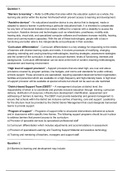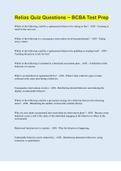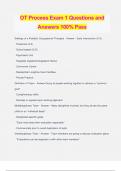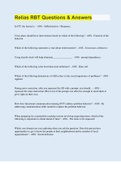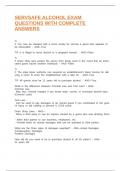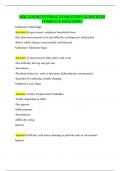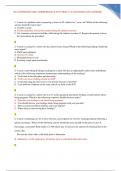Question 1:
“Barriers to learning” – Refer to difficulties that arise within the education system as a whole, the
learning site and/or within the learner him/herself which prevent access to learning and development.
“Assistive devices” - An educational assistive device is any device that is designed, made or
adapted to assist a learner in performing a particular educational task. It is intended to compensate
for any form of functional limitation that makes it difficult for a learner with a disability to access the
curriculum. Assistive devices and technologies such as wheelchairs, prostheses, mobility aids,
hearing aids, visual aids, and specialized computer software and hardware increase mobility, hearing,
vision and communication capacities. With the aid of these technologies, people with a loss in
functioning are better able to live independently and participate in their societies.
“Curriculum differentiation” - Curriculum differentiation is a key strategy for responding to the needs
of learners with diverse learning styles and needs. It involves processes of modifying, changing,
adapting, extending and varying teaching methodologies, teaching strategies, assessment strategies
and the content of the curriculum. It takes into account learners’ levels of functioning, interests and
backgrounds. Curriculum differentiation can be done at the level of content, teaching methodologies,
assessment and learning environment.
“High level of support provision” - Support provisions that are rated high, are over and above
provisions covered by program policies, line budgets, and norms and standards for public ordinary
schools support. These provisions are specialized, requiring specialist classroom/school organization,
facilities and personnel which are available on a high-frequency and high-intensity basis. A high level
of support provision will be available at special schools but should not be seen as site restricted.
“District-based Support Team (DBST)” – A management structure at district level, the
responsibility of which is to coordinate and promote inclusive education through: training; curriculum
delivery; distribution of resources; infrastructure development; identification, assessment and
addressing of barriers to learning. The DBST must provide leadership and general management to
ensure that schools within the district are inclusive centres of learning, care and support. Leadership
for the structure must be provided by the District Senior Management that could designate transversal
teams to provide support.
“Program of support” – Programs of support refer to structured interventions delivered at schools
and in classrooms within specific time frames. The following support programs should be put in place
to address barriers that prevent access to the curriculum:
a) Provision of specialist services by specialized professional staff
b) Curriculum differentiation which includes adjustments and accommodations in assessment
c) Provision of specialized Learning and Teaching Support Material and assistive technology
d) Training and mentoring of teachers, managers and support staff.
Question 2:
2.1 Barriers to learning and development may include:
, a) Socio-economic aspects (such as lack of access to basic services, poverty and under-
development)
b) Factors that place learners at risk, for example, physical, emotional and sexual abuse, political
violence, HIV and AIDS and other chronic health conditions
c) Attitudes
d) Inflexible curriculum implementation at schools
e) Language and communication
f) Inaccessible and unsafe structural environments
g) Inappropriate and inadequate provision of support services
h) Lack of parental recognition and involvement
i) Disability
j) Lack of human resource development strategies
k) Unavailability of accessible learning and teaching support materials and assistive technology.
Intrinsic factors
Intrinsic causes refer to factors within the learner himself. These include birth defects, physical
impairments, neurological disorders, sensory impairments, medical conditions, intellectual
impairment, attention deficit disorders (ADD) as well as emotional issues.
Intrinsic factors that can cause learning barriers
Intrinsic factors
Birth defects
Medical conditions
Emotional disabilities
Intellectual disabilities
Physical and Neurological impairments
Sensory impairments
2.4.1.2 Extrinsic factors
When we talk about extrinsic factors that cause learning barriers and lead to learning difficulties, we
refer to factors outside the learner. These include factors within the family as primary educational
institution, for example the child-rearing style of the parents, child-rearing errors made by the parents,
the child's position in the family and in many cases, the disintegration of family life. Also included are
socio-economic factors that have a definite influence on the family and the child, for example
poverty, unemployment, HIV/Aids, crime and the deterioration of value systems (see Figure 7).
Extrinsic factors
Negative attitudes
Inflexible curriculum
Unsafe environment
Poverty
HIV/Aids
2.2 PRINCIPLES OF SUPPORT
(1) Support should no longer focus only on the diagnosis and remediation of deficits in individual
learners through individual attention by specialist staff. The SIAS shifts the focus to a holistic
“Barriers to learning” – Refer to difficulties that arise within the education system as a whole, the
learning site and/or within the learner him/herself which prevent access to learning and development.
“Assistive devices” - An educational assistive device is any device that is designed, made or
adapted to assist a learner in performing a particular educational task. It is intended to compensate
for any form of functional limitation that makes it difficult for a learner with a disability to access the
curriculum. Assistive devices and technologies such as wheelchairs, prostheses, mobility aids,
hearing aids, visual aids, and specialized computer software and hardware increase mobility, hearing,
vision and communication capacities. With the aid of these technologies, people with a loss in
functioning are better able to live independently and participate in their societies.
“Curriculum differentiation” - Curriculum differentiation is a key strategy for responding to the needs
of learners with diverse learning styles and needs. It involves processes of modifying, changing,
adapting, extending and varying teaching methodologies, teaching strategies, assessment strategies
and the content of the curriculum. It takes into account learners’ levels of functioning, interests and
backgrounds. Curriculum differentiation can be done at the level of content, teaching methodologies,
assessment and learning environment.
“High level of support provision” - Support provisions that are rated high, are over and above
provisions covered by program policies, line budgets, and norms and standards for public ordinary
schools support. These provisions are specialized, requiring specialist classroom/school organization,
facilities and personnel which are available on a high-frequency and high-intensity basis. A high level
of support provision will be available at special schools but should not be seen as site restricted.
“District-based Support Team (DBST)” – A management structure at district level, the
responsibility of which is to coordinate and promote inclusive education through: training; curriculum
delivery; distribution of resources; infrastructure development; identification, assessment and
addressing of barriers to learning. The DBST must provide leadership and general management to
ensure that schools within the district are inclusive centres of learning, care and support. Leadership
for the structure must be provided by the District Senior Management that could designate transversal
teams to provide support.
“Program of support” – Programs of support refer to structured interventions delivered at schools
and in classrooms within specific time frames. The following support programs should be put in place
to address barriers that prevent access to the curriculum:
a) Provision of specialist services by specialized professional staff
b) Curriculum differentiation which includes adjustments and accommodations in assessment
c) Provision of specialized Learning and Teaching Support Material and assistive technology
d) Training and mentoring of teachers, managers and support staff.
Question 2:
2.1 Barriers to learning and development may include:
, a) Socio-economic aspects (such as lack of access to basic services, poverty and under-
development)
b) Factors that place learners at risk, for example, physical, emotional and sexual abuse, political
violence, HIV and AIDS and other chronic health conditions
c) Attitudes
d) Inflexible curriculum implementation at schools
e) Language and communication
f) Inaccessible and unsafe structural environments
g) Inappropriate and inadequate provision of support services
h) Lack of parental recognition and involvement
i) Disability
j) Lack of human resource development strategies
k) Unavailability of accessible learning and teaching support materials and assistive technology.
Intrinsic factors
Intrinsic causes refer to factors within the learner himself. These include birth defects, physical
impairments, neurological disorders, sensory impairments, medical conditions, intellectual
impairment, attention deficit disorders (ADD) as well as emotional issues.
Intrinsic factors that can cause learning barriers
Intrinsic factors
Birth defects
Medical conditions
Emotional disabilities
Intellectual disabilities
Physical and Neurological impairments
Sensory impairments
2.4.1.2 Extrinsic factors
When we talk about extrinsic factors that cause learning barriers and lead to learning difficulties, we
refer to factors outside the learner. These include factors within the family as primary educational
institution, for example the child-rearing style of the parents, child-rearing errors made by the parents,
the child's position in the family and in many cases, the disintegration of family life. Also included are
socio-economic factors that have a definite influence on the family and the child, for example
poverty, unemployment, HIV/Aids, crime and the deterioration of value systems (see Figure 7).
Extrinsic factors
Negative attitudes
Inflexible curriculum
Unsafe environment
Poverty
HIV/Aids
2.2 PRINCIPLES OF SUPPORT
(1) Support should no longer focus only on the diagnosis and remediation of deficits in individual
learners through individual attention by specialist staff. The SIAS shifts the focus to a holistic

